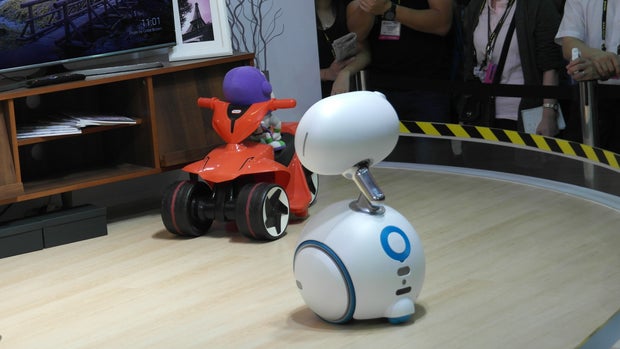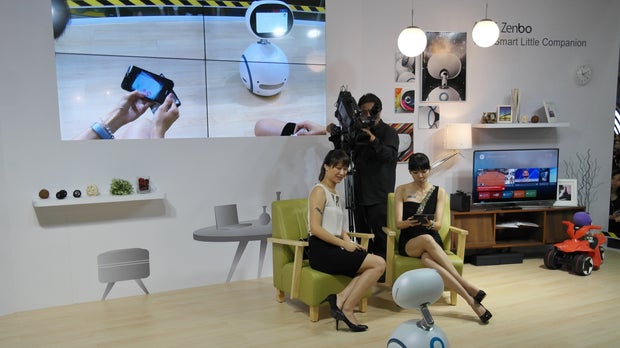Asus shows us its Zenbo robot butler – but can it make the tea?

A robot butler is the thing of dreams, but Zenbo is still a long way from replacing a 'gentleman's gentleman'
Who wouldn’t like a robotic helper around the house to ease your domestic chores. Wooster had Jeeves, Batman had Alfred and even Blackadder helped out the Prince of Wales once in a while. The tech industry has been somewhat obsessed with helping out around the home in recent years, but is yet to come up with anything that can iron, make the tea and drop the kids off at school. So let’s see if Zenbo can do any better.
Zenbo is apparently the brain child of Asus Chairman Jonney Shih, who had an ambition to ‘enable robotic computing for every household’. This $599 home robot is designed to do just that, providing assistance, entertainment, and companionship to families.
With a wide range of capabilities, including the ability to move independently and understand spoken commands, Zenbo is all about assisting family members in the home as a mechanical care assistant, looking after all your tech needs. While we couldn’t get hands-on with Zenbo, we got to see him in action at a live demo at the Computex show floor to see how well he performed the actions Asus promises. Here’s our initial thoughts.
The first thing you’ll notice about Zenbo is his ET-like form and pet-like expressions. With a wide head, tiny neck and chunky body, Zenbo has been designed to appeal, with big dopey eyes to make him more friendly looking. His two large motorised wheels means he can move about depending on where nearby people are situated, and will also interact with his surroundings on his own accord.
Interacting with Zenbo appears easy, and works in a very similar way to Apple’s voice assistant – Zenbo basically is Siri with wheels. In order to summon him, you just have to call out his name loud enough for him to hear it, and he’ll respond with a short chime, prompting you to ask him a question or give him a command.

We don’t know the technical ins and outs of Zenbo just yet, but he has an oval-shape tablet for a face, measuring what we’d guess is somewhere between 8 and 10-inches. This display can change rapidly depending on what he wants to show you, or what you’ve asked of him, whether it be an Amazon webpage to help you shop, your media library, or YouTube videos. His default screen (or face) is his expressive eyes, which respond to what’s going on around him. For example, looking happy when he is getting attention, sad when he’s being ignored, or even sometimes angry as the below pic shows.

Some of the features we saw Zenbo perform at the show included controlling smart home and traditional IR devices, including lights, TVs, air conditioners, and even door locks, as well as helping out in the kitchen, reading recipes out loud and functioning as a voice-controlled timer.
Zenbo also has a built-in camera, which when paired with his ability to move around the house, means he can become a family photographer, taking shots of you wherever. (Though let’s hope he only does this when you ask him to). When homeowners are away, Zenbo also acts as a remote-controlled home security camera that is accessible from anywhere via a smartphone app
Asus’ house bot also has specific functionality that helps older family members safeguard their health by acting as a home care assistant. He can provides spoken reminders of important information, such as doctor’s appointments, medication and exercise schedules, but more interestingly, he monitors the home for emergency situations — such as falls — and immediately responds to them by notifying specified family members on their smartphones. When they receive an emergency notification, family members can remotely control Zenbo to move nearby and use its built-in camera to check on their loved one.

When seeing Zenbo perform this task on the show floor, it didn’t seem as fluid as I’d expect, and video took a while to connect between Zenbo and the user’s smartphone. Then again this could be down to bandwidth issues at the show, or because the system being demoed was an early production model.
Asus is hoping Zenbo will be purchased by schools or families with young children to act as an educational playmate and I can see this being one of the more popular applications. I think kids will love it, so can see families being pressured into buying one just because their children saw him on TV. I can’t imagine him being as compelling for younger adults, or the more tech savvy, as it would probably be quicker just to perform the actions he does yourself.
Nevertheless, Asus is really pushing the idea of Zenbo and want to make him future-proof by making sure he supports a growing number of custom apps that expand his capabilities, bringing new features to users. The firm has already launched a free Zenbo Developer Programme to make sure this happens, this will provide access to the Zenbo SDK and a library of information they need to bring new apps and features onboard, so he could do even more in the next year or so.
He may not yet be the robot butler of our dreams but Zenbo does appear to have some handy, if niche, uses and we’ll keep an eye on his development.









